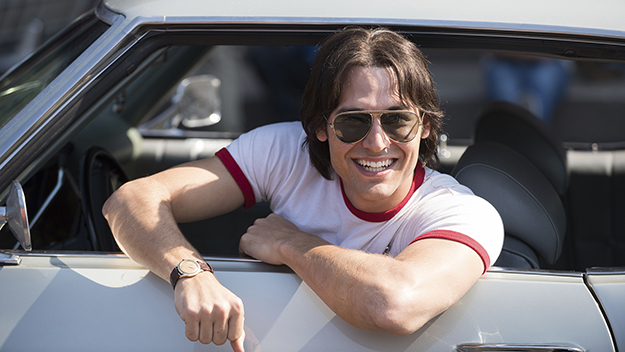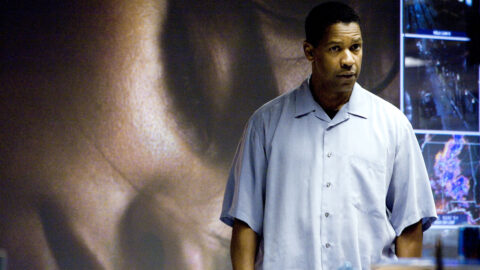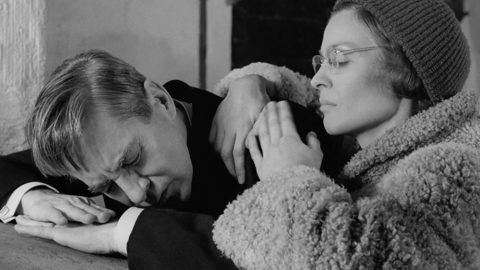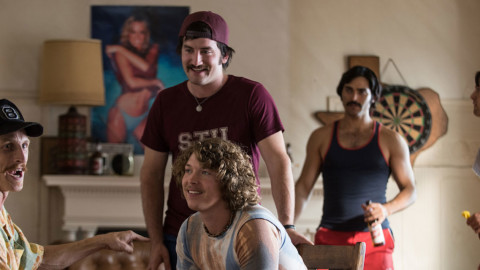Seeing Double: Shane & Everybody Wants Some!!
This article appeared in the September 2 edition of The Film Comment Letter, our free weekly newsletter featuring original film criticism and writing. Sign up for the Letter here.

Everybody Wants Some!! (Richard Linklater, 2016)
In the final scene of Richard Linklater’s 2016 film Everybody Wants Some!!, a history professor stands before the class on the first day of school and writes on the board, “FRONTIERS ARE WHERE YOU FIND THEM.” They are everywhere. Always. A couple of years ago, on a hot August day, my friend Mitchell and I watched two films back to back, both of which are interested in frontiers. Both also happen to be about masculinity, its enforced boundaries, limitations, and possibilities. The frontiers are not just geographical. They are psychological.
First, we watched George Stevens’s 1953 classic Shane on TCM. We had both seen it many times, so it was well-worn and pleasurable territory. Then, on a whim, we popped in Everybody Wants Some!!. Afterwards, we discussed how these two movies—from two different genres, not to mention eras—spoke to each other in fascinating ways. We sensed in both a conscious yet subtle destabilizing of the cinematic archetypes of traditional masculinity. Neither film makes this destabilization explicit; both embed it in the atmospheres in which the characters operate. They are sneakily subversive movies. Blink and you might miss their undertones.
Both take place in stereotypically male worlds bristling with stereotypically manly pursuits: in Shane, it’s ranching and gunslinging; in Everybody Wants Some!!, it’s the jock world of college baseball. Set in rural Wyoming, Shane is ostensibly a western in which cattle ranchers threaten homesteaders, whom they don’t regard as “real” men. Into this tinderbox strolls Shane (Alan Ladd), a mysterious gunslinger who takes up a job on homesteader Joe Starrett’s farm. Shane’s charisma works on each member of his host family: Joe (Van Heflin), his wife Marian (Jean Arthur, in her final film performance), and small son Joey (Brandon De Wilde). Joey’s idol worship of Shane frankly reads as a crush, and so does Joe’s desire to prove himself to Shane, albeit in a different key. Shane makes Joe want to be better, braver, stronger. Meanwhile, Marian goes out of her way to bake a pie for this taciturn hunk in buckskins.
Shane’s disinclination to throw his weight around is misread as weakness by the ranchers, who treat him with suspicion, sneering when he orders a “sodapop” instead of a whiskey. Secure in his masculinity, Shane doesn’t have to make a strutting display of it. He fights back only when there is no other choice, when the Starrett family is threatened. This refusal to “play along” in the macho ritual disturbs the ranchers, laying bare their limitations as men. Shane must be destroyed for this. One thinks of the opening chapters of Billy Budd, where Melville describes the complex reactions among the crew of HMS Bellipotent to the glamorous new guy—one sailor, “out of envy, perhaps, of the newcomer, and thinking such a ‘sweet and pleasant fellow,’ as he mockingly designated him to the others, could hardly have the spirit of a gamecock, must needs bestir himself in trying to get up an ugly row with him.” A similar dynamic is at play in Shane. Better to have an “ugly row” than to face these complicated feelings of desire and wish-fulfillment. Shane presents another model for moving through the world as a man, one that sacrifices nothing (he is strong and brave), but which allows for sensitivity, quiet listening, kindness.
Linklater’s Everybody Wants Some!! is set in 1980 and opens with a shot of a milk crate full of records, with Devo’s Q: Are We Not Men?… on prominent display. The New Wave band’s question turns out to be an honest one, posed over and over again. Over four days, the college boys at the center of the film cruise for chicks, attend parties, and engage in competitive battles ranging from ping pong to bong hits. Amid all these ritualistic shenanigans, the film includes unexpected moments of tenderness and thoughtfulness, and shows the guys’ willingness to toss themselves into different environments. When they go to a theater party, they wear costumes and participate in skits. At a punk show they are, frankly, frightened, until they succumb to the fun and throw themselves into the mosh pit. They line dance at the country bar, and do the hustle at the disco. In between these destinations, they go home to change their clothes, from silk shirts into cowboy boots into sleeveless vests. It’s not just camouflage. They adapt. They are always on the prowl, but the girls they encounter are up for fun, too. Nobody’s getting used. In stereotypical “dudebro” movies, women are often presented as hot party girls or interchangeable conquests (or, worse, “manic pixie dream girls”). The girls in Everybody Wants Some!! have a lot of power. There are a couple of male characters here who can’t adapt, who throw tantrums, who assert their dominance with women, with bartenders, with the other players, bristling with hostility behind a fortified facade. They haven’t figured out yet that the best frontiers are porous.
Shane and Everybody Wants Some!! create spaces where traditional masculinity is both undermined and redeemed. In both films, the men who aren’t able to let their guard down suffer. They’re trapped. They can’t enjoy life in all its possibilities. They may desire women but they cannot have relationships or allow themselves to be soft (i.e. open and present). In Everybody Wants Some!!, the free-spirited stoner Willoughby (Wyatt Russell) advises his freshman acolyte not to worry about the rules for men. Instead: “Bring who you are—never who they want—and that, my friend, is when it gets fun.” Or deep. Or pleasurable. Or free.
Sheila O’Malley is a regular film critic for Rogerebert.com and other outlets including The Criterion Collection. Her blog is The Sheila Variations.






